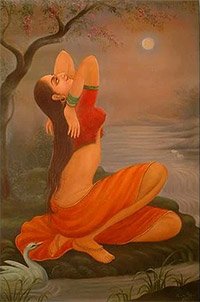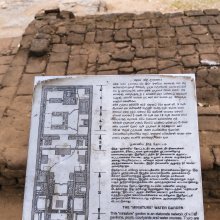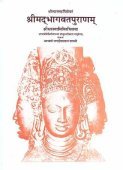Krida, Krīḍā, Krīḍa: 21 definitions
Introduction:
Krida means something in Hinduism, Sanskrit, Jainism, Prakrit, Hindi. If you want to know the exact meaning, history, etymology or English translation of this term then check out the descriptions on this page. Add your comment or reference to a book if you want to contribute to this summary article.
Images (photo gallery)
In Hinduism
Shaivism (Shaiva philosophy)
Source: Wisdom Library: Ṣaṭsāhasra-saṃhitāKrīḍā (क्रीडा):—One of the twelve guṇas associated with Piṇḍa, the seventh seat of the Svādhiṣṭhāna-chakra. According to tantric sources such as the Śrīmatottara-tantra and the Gorakṣasaṃhitā (Kādiprakaraṇa), these twelve guṇas are represented as female deities. According to the Ṣaṭsāhasrasaṃhitā however, they are explained as particular syllables. They (e.g. Krīḍā) only seem to play an minor role with regard to the interpretation of the Devīcakra (first of five chakras, as taught in the Kubjikāmata-tantra).
Source: Brill: Śaivism and the Tantric TraditionsKrīḍā (क्रीडा) refers to “playing”, according to the Vārāṇasīmāhātmya verse 3.7ff.—[...] In chapter 3, the apparent contradiction in Śiva’s behaviour is articulated by Brahmā, who says that those who have no faith see the path of the world, viz. the Laukika and Apavargika, on the one hand, and the great path, the Lokottara, on the other, as a contradiction: [...] But in God the two paths are united. In him there is no contradiction. His ways are inscrutable; only he can unite these contradictions and he does so because he delights in play (krīḍā).
Source: SOAS University of London: Protective Rites in the Netra TantraKrīḍā (क्रीडा) refers to “playing (in contests)” (with weapons), according to the Netratantra of Kṣemarāja: a Śaiva text from the 9th century in which Śiva (Bhairava) teaches Pārvatī topics such as metaphysics, cosmology, and soteriology.—Accordingly, [verse 19.92-94ab, while describing the ritual that protect the king and his kingdom]—“When [the king] is at play with horses and elephants or in contests with weapons (astra-krīḍā), [the mantrin] should venerate the water pot in order to protect him. [The mantrin] should perform this auspicious protection, which offers all benefits, whether [the king] is at play or for victory [in battle] in order to protect him from [the] many enemies that wish to destroy the king”.

Shaiva (शैव, śaiva) or Shaivism (śaivism) represents a tradition of Hinduism worshiping Shiva as the supreme being. Closely related to Shaktism, Shaiva literature includes a range of scriptures, including Tantras, while the root of this tradition may be traced back to the ancient Vedas.
Purana and Itihasa (epic history)
Source: archive.org: Shiva Purana - English TranslationKrīḍa (क्रीड) refers to “sport” (i.e., Śiva’s sport with Śivaśakti), according to the Śivapurāṇa 2.2.41.—Accordingly, as Viṣṇu and others eulogized Śiva:—“[...] O great lord, the lord of the gods and the prescriber of worldly conventions, we know you to be Śiva and Brahman, thanks to your favour. [...] You alone create, sustain and annihilate the universe under your control like a spider (weaving its web). You sport (i.e., krīḍa) about with Śivaśakti—your own manifestation”.
Source: Cologne Digital Sanskrit Dictionaries: The Purana IndexKrīḍa (क्रीड).—A Rākṣasa.*
- * Vāyu-purāṇa 69. 166.

The Purana (पुराण, purāṇas) refers to Sanskrit literature preserving ancient India’s vast cultural history, including historical legends, religious ceremonies, various arts and sciences. The eighteen mahapuranas total over 400,000 shlokas (metrical couplets) and date to at least several centuries BCE.
Dharmashastra (religious law)
Source: Knowledge Traditions & Practices of India: Education: Systems & PracticesKrīḍā (क्रीडा) refers to “games and recreational activities” and formed part of the ancient Indian education system, which aimed at both the inner and the outer dimension of a person. Truth, patience, regularity, self-mastery, humility, self-denial, purity of self (sattvaśuddhi), cognition of the underlying unity of life, nature and environment, reverence for all-beings were the inner values cultivated by Indian education.

Dharmashastra (धर्मशास्त्र, dharmaśāstra) contains the instructions (shastra) regarding religious conduct of livelihood (dharma), ceremonies, jurisprudence (study of law) and more. It is categorized as smriti, an important and authoritative selection of books dealing with the Hindu lifestyle.
Shaktism (Shakta philosophy)
Source: Google Books: ManthanabhairavatantramKrīḍā (क्रीडा) (cf. Kāmakrīḍā) refers to “play” or “sport” (e.g., the sport of love), according to the second recension of the Yogakhaṇḍa of the Manthānabhairavatantra, a vast sprawling work that belongs to a corpus of Tantric texts concerned with the worship of the goddess Kubjikā.—Accordingly, as the God said to the Goddess, “Today be Bhadrakālī. (It is) I, Śaṃkara who has come. Mutually we play [i.e., krīḍā] up to the end of the cosmic age. (We are) mutually Rati and Kāma (for one another)”.

Shakta (शाक्त, śākta) or Shaktism (śāktism) represents a tradition of Hinduism where the Goddess (Devi) is revered and worshipped. Shakta literature includes a range of scriptures, including various Agamas and Tantras, although its roots may be traced back to the Vedas.
Kama-shastra (the science of Love-making)
Source: Shodhganga: Elements of Art and Architecture in the Trtiyakhanda of the Visnudharmottarapurana (kama)Krīḍā (क्रीडा) refers to “making models (from yarns or threads)”.—Cf. Sūtrakrīḍā which representing one of the “sixty four kinds of Art”, according to the Kāmasūtra of Vātsyāyaṇa.—Indian tradition, basically includes sixty four Art forms are acknowledged. The references of sixty four kinds of kalā are found in the Bhāgavatapurāṇa, Śaiva-Tantras, Kāmasūtra of Vātsyāyaṇa etc.

Kamashastra (कामशास्त्र, kāmaśāstra) deals with ancient Indian science of love-making, passion, emotions and other related topics dealing with the pleasures of the senses.
Sports, Arts and Entertainment (wordly enjoyments)
Source: archive.org: Syainika Sastra of Rudradeva with English Translation (art)Krīḍā (क्रीडा) refers to “playing” (with animate or inanimate objects) (in a game of dice), according to the Śyainika-śāstra: a Sanskrit treatise dealing with the divisions and benefits of Hunting and Hawking, written by Rājā Rudradeva (or Candradeva) in possibly the 13th century.—Accordingly, “[...] It has been said that there are eighteen addictions. These are the outcome of the desire for earthly enjovments. [...] Gambling is laying a wager in playing (krīḍā) with animate or inanimate objects. If well managed it leads to the increase of wealth and desires. [...]”.

This section covers the skills and profiencies of the Kalas (“performing arts”) and Shastras (“sciences”) involving ancient Indian traditions of sports, games, arts, entertainment, love-making and other means of wordly enjoyments. Traditionally these topics were dealt with in Sanskrit treatises explaing the philosophy and the justification of enjoying the pleasures of the senses.
In Jainism
General definition (in Jainism)
Source: The University of Sydney: A study of the Twelve ReflectionsKrīḍā (क्रीडा) refers to “playful (knowledge)”, according to the 11th century Jñānārṇava, a treatise on Jain Yoga in roughly 2200 Sanskrit verses composed by Śubhacandra.—Accordingly, “Certainly in this world the one knowing the higher knowledge constantly obtains fearlessness [and] happiness that is beyond the senses [and] imperishable through the reflections with playful knowledge [com.—through those with playful knowledge of the doctrine (dharmakrīḍājñābhiḥ)]. The fire of passion becomes extinguished, desire flows away, darkness disappears [and] the light of knowledge shines forth in the heart for men from the repetition of the reflections”.
Synonyms: Dīvya, Dīvyat.

Jainism is an Indian religion of Dharma whose doctrine revolves around harmlessness (ahimsa) towards every living being. The two major branches (Digambara and Svetambara) of Jainism stimulate self-control (or, shramana, ‘self-reliance’) and spiritual development through a path of peace for the soul to progess to the ultimate goal.
Languages of India and abroad
Sanskrit dictionary
Source: DDSA: The practical Sanskrit-English dictionaryKrīḍa (क्रीड).—a. [krīḍ-ghañ] Playing, sporting; क्रीडं (krīḍaṃ) (ḷaṃ) वः शर्धो मारुतम् (vaḥ śardho mārutam) Ṛgveda 1.37.1,5.
-ḍaḥ 1 Sport, pastime, play, pleasure.
2) Jest, joke.
--- OR ---
Krīḍā (क्रीडा).—[krīḍ-bhāve a]
1) Sport, pastime, play, pleasure; तोयक्रीडानिरतयुवतिस्नानतिक्तैर्मरुद्भिः (toyakrīḍāniratayuvatisnānatiktairmarudbhiḥ) Meghadūta 35,63; क्रीडामुदो यातनाः (krīḍāmudo yātanāḥ) Gītagovinda 9.9.
2) Jest, joke.
3) (in music) A kind of measure.
4) A play-ground; Mahābhārata (Bombay) 3.
Source: Cologne Digital Sanskrit Dictionaries: Shabda-Sagara Sanskrit-English DictionaryKrīḍa (क्रीड).—mf.
(-ḍaḥ-ḍā) 1. Sport, play, pastime, pleasure, amusement. f.
(-ḍā) 1. Playing, as a ball, &c. 2. Disrespect. E. krīḍ. to play, a affix, and fem. do ṭāp.
Source: Cologne Digital Sanskrit Dictionaries: Benfey Sanskrit-English DictionaryKrīḍā (क्रीडा).—[krīḍ + ā], f. 1. Play, [Rāmāyaṇa] 3, 39, 17; jest, [Gītagovinda. ed. Lassen.] 9, 10. 2. Amusement, [Rājataraṅgiṇī] 5, 338.
Source: Cologne Digital Sanskrit Dictionaries: Cappeller Sanskrit-English DictionaryKrīḍa (क्रीड).—[adjective] playing, sporting; [feminine] krīḍā play, sport, amusement.
Source: Cologne Digital Sanskrit Dictionaries: Monier-Williams Sanskrit-English Dictionary1) Krīḍa (क्रीड):—[from krīḍ] mfn. playing, sporting (said of the winds), [Ṛg-veda i, 37, 1 and 5; 166, 2]
2) [v.s. ...] m. sport, play, [cf. Lexicographers, esp. such as amarasiṃha, halāyudha, hemacandra, etc.]
3) Krīḍā (क्रीडा):—[from krīḍa > krīḍ] a f. sport, play, pastime, amusement, amorous sport (often in [compound] e.g. krīḍā-mudaḥ f. [plural] the pleasures of playing or of amorous sport, [Gīta-govinda ix, 9]; kṛṣṇa-k, sport with Kṛṣṇa, [Bhāgavata-purāṇa ii, 3, 15]; jala-k, playing about in water, [Mahābhārata; Pañcatantra; Bhāgavata-purāṇa]; toya-k idem, [Meghadūta]), [Vājasaneyi-saṃhitā xviii, 5; Rāmāyaṇa; Suśruta] etc.
4) [v.s. ...] working miracles for one’s amusement, [Lalita-vistara]
5) [v.s. ...] disrespect shown by jest or joke, [cf. Lexicographers, esp. such as amarasiṃha, halāyudha, hemacandra, etc.]
6) [v.s. ...] a play-ground, [Mahābhārata iii, 12318]
7) [v.s. ...] (in music) a kind of measure.
8) [from krīḍ] b (f. of ḍa q.v.)
Source: Cologne Digital Sanskrit Dictionaries: Yates Sanskrit-English DictionaryKrīḍa (क्रीड):—(ṛ) krīḍati 1. a. To play. With anu, ava, ā, pari, or saṃ commonly used in the middle voice.
Source: DDSA: Paia-sadda-mahannavo; a comprehensive Prakrit Hindi dictionary (S)Krīḍā (क्रीडा) in the Sanskrit language is related to the Prakrit words: Kiḍḍā, Kīlā, Kheḍḍā.
[Sanskrit to German]
Sanskrit, also spelled संस्कृतम् (saṃskṛtam), is an ancient language of India commonly seen as the grandmother of the Indo-European language family (even English!). Closely allied with Prakrit and Pali, Sanskrit is more exhaustive in both grammar and terms and has the most extensive collection of literature in the world, greatly surpassing its sister-languages Greek and Latin.
Hindi dictionary
Source: DDSA: A practical Hindi-English dictionaryKrīḍā (क्रीडा):—(nf) play, game, sport, dalliance; fun; —[kautuka] fun and frolic.
...
Nepali dictionary
Source: unoes: Nepali-English DictionaryKrīḍā (क्रीडा):—n. 1. sport; play; pleasure; amusement; 2. sexual intercourse; copulation;
Nepali is the primary language of the Nepalese people counting almost 20 million native speakers. The country of Nepal is situated in the Himalaya mountain range to the north of India.
See also (Relevant definitions)
Starts with (+101): Kridabhihita, Kridabhiramam, Kridabhuvana, Kridabidalika, Kridabrahmavada, Kridacakra, Kridacala, Kridacandra, Kridacankramana, Kridachandra, Kridagolaka, Kridagriha, Kridajna, Kridaka, Kridakalaha, Kridakanana, Kridakapitva, Kridakara, Kridakasara, Kridakaushala.
Ends with (+39): Agnikrida, Akarshakrida, Akrida, Akshakrida, Aksharakrida, Anangakrida, Astrakrida, Atmakrida, Balakrida, Brahmaramayane rasakrida, Candrakrida, Caturangakrida, Devakrida, Devikrida, Dharmakrida, Dyutakrida, Golakrida, Gulikakrida, Hamsakrida, Jalakrida.
Full-text (+148): Kridaratna, Kridaratha, Jalakrida, Pankakrida, Kridakopa, Agnikrida, Kridamriga, Manavakakrida, Kridana, Kridakanana, Kridaveshman, Balakrida, Kridakuta, Gulikakrida, Akrida, Kridasaras, Kridatala, Kridasthana, Kridashaila, Kridanari.
Relevant text
Search found 44 books and stories containing Krida, Krīḍā, Krīḍa, Kreedaa; (plurals include: Kridas, Krīḍās, Krīḍas, Kreedaas). You can also click to the full overview containing English textual excerpts. Below are direct links for the most relevant articles:
Garga Samhita (English) (by Danavir Goswami)
Verse 2.6.1 < [Chapter 6 - The Liberation of Aghāsura]
Verse 2.24.11 < [Chapter 24 - The Story of Asuri Muni in the Rāsa-dance Pastime]
Verse 3.7.6 < [Chapter 7 - The Holy Places of Śrī Girirāja]
Brihad Bhagavatamrita (commentary) (by Śrī Śrīmad Bhaktivedānta Nārāyana Gosvāmī Mahārāja)
Verse 2.1.202 < [Chapter 1 - Vairāgya (renunciation)]
Verse 1.7.144 < [Chapter 7 - Pūrṇa (pinnacle of excellent devotees)]
Verse 2.4.223 < [Chapter 4 - Vaikuṇṭha (the spiritual world)]
Chaitanya Bhagavata (by Bhumipati Dāsa)
Verse 3.4.163 < [Chapter 4 - Descriptions of Śrī Acyutānanda’s Pastimes and the Worship of Śrī Mādhavendra]
Verse 1.1.22 < [Chapter 1 - Summary of Lord Gaura’s Pastimes]
Verse 1.1.33 < [Chapter 1 - Summary of Lord Gaura’s Pastimes]
Sahitya-kaumudi by Baladeva Vidyabhushana (by Gaurapada Dāsa)
Text 10.121 < [Chapter 10 - Ornaments of Meaning]
Text 7.133 < [Chapter 7 - Literary Faults]
Text 11.4 [Bindu-cyutaka] < [Chapter 11 - Additional Ornaments]
Śrī Kṛṣṇa-vijaya (by Śrī Gunaraja Khan)
Chapter 11 - Lord Kṛṣṇa and His Associates in the Spiritual World of Vṛndāvana (Śri-rāga)
Chapter 7 - The Brāhmanas' Wives Offer Prayers to Lord Kṛṣṇa (Mallāra-rāga)
Chapter 2 - Description of Lord Kṛṣṇa's Handsome Form (vibhāṣā-rāga)
Bhajana-Rahasya (by Srila Bhaktivinoda Thakura Mahasaya)
Related products

